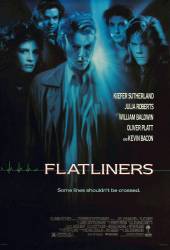Factual error: Asystole (the lack of cardiac activity, also known as the 'flatline') is not treated with defibrillation (electric shocks) but with alternating doses of the drugs epinephrine and atropine.
Continuity mistake: Rachel's father kills himself after returning home from the Vietnam war (presumably in the early 70's) addicted to morphine. The problem with this is that he kills himself in a 1978 or '79 Ford pickup - Ford did not produce any pick-ups with square headlights until those years.
Revealing mistake: When Nelson first undergoes the experiment, the doctors use a small mask to put him to sleep. When he is supposedly waking up, Rachel asks Randy to help her with oxygen. He hands her the same small mask they used the first time ie. anesthetic. Just for a second she has a look on her face which says "this is the wrong mask" and she tries to hide it with her hand. For the whole rest of the film, the other doctors use a bigger mask when giving oxygen.
Continuity mistake: In one of the final scenes where Nelson puts himself under, before he injects himself, he doesn't put the suction pads all over his face and chest to track his vitals. Yet when his friends come in, the first thing they check is the EKG machine to check his vitals, which it is displaying. After this, they show Nelson again, and he has the suction pads on his body. How did they get there?
Continuity mistake: When Rachel's father supposedly kills himself in the truck there is a golf ball size hole in the windshield. If he'd used a gun with large caliber the windshield would be destroyed and there would be hair, skull and brain on the windshield, not just blood.
Continuity mistake: When we first see David, he has an argument with Nelson as he packs his stuff into his truck. At the end of the argument, David pulls the rope down, pulling the canvas tight and closing the back of the truck. There is a shot of Nelson, then back to David who pulls on the rope and closes the back of the truck again.
Factual error: When they jump-start Rachel's heart, she's wearing a bra. As medical students, one of the first things they would have learned is CPR and the use of defibrillators. They should have known to remove things like that or the electricity would have left burns on her chest, particularly where any metal touches.
Factual error: Nelson crosses a vacant street and enters a subway station where he encounters the child ghost that is haunting him. The corner exists, it is called "Six Corners" because three streets come together, and is in Chicago's Wicker Park Neighborhood. However, the train station at that corner is an elevated train, not a subway - this scene is filmed at Damen, Milwaukee, and North Avenues. The real Six Corners is Cicero Ave, Irving Park Rd, and Milwaukee Ave.
Revealing mistake: Rachel's father's suicide: After he heads down the stairs (during her death experiment), we suddenly hear a popping sound like a gunshot, as the girl follows her mother outside, to see glass littering the pavement. Then the camera flipping to shots of an old pickup parked on the curbside. And a single bloodied gunshot hole through the windshield. Which would not have happened within the 5-second time, between the stairs and the curb.
Visible crew/equipment: When the rest of the cast try to revive Nelson at the end of the film, they try defibrillating him and check his vitals afterwards. There's one shot when the camera zooms into the screen of the heart rate monitor. In the screen reflection, a camera and camera operator are visible.
Factual error: Julie Roberts can't intubate because the trachea is "tight." This is laryngospasm, the vocal cords clamping shut. If so, neither mouth to mouth nor mask will work, but more importantly, no heart beat equals no blood to muscles, and they would relax and be open anyway. I think they just didn't want to fake a half tube coming out of Sutherland's mouth.






Answer: Billy forgave Nelson. he saw that Nelson was willing to die to be forgiven. That's why Billy smiled.
MasterOfAll